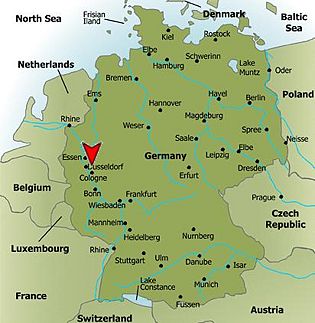Neanderthal: Difference between revisions
imported>Angela Rovak No edit summary |
imported>Angela Rovak No edit summary |
||
| Line 10: | Line 10: | ||
==Discovery== | ==Discovery== | ||
[[Image:Neander valley.JPG|right|thumb|315px|{{#ifexist:Template:Neander valley.JPG/credit|{{Neander valley.JPG/credit}}<br/>|}} | [[Image:Neander valley.JPG|right|thumb|315px|{{#ifexist:Template:Neander valley.JPG/credit|{{Neander valley.JPG/credit}}<br/>|}}Neandertal, Germany.]] | ||
Neanderthals were first acknowledged as a skull and other various bones were found by miners at a limestone quarry in Neander Valley, Germany. The Neander Valley of the river Düssel in the German Federal State of North Rhine-Westphalia, belonging to the small towns of Erkrath and Mettmann. The partial skeleton was found in Feldhofer Cave consisting of a skull cap, two femora, five arm bones, part of the left ilium, portions of a scapula, and ribs. The material was turned over to an anatomy professor at the University of Bonn, and in accordance with Johann Karl Fuhlrott, Neanderthal 1 was announced in 1857. | Neanderthals were first acknowledged as a skull and other various bones were found by miners at a limestone quarry in Neander Valley, Germany. The Neander Valley of the river Düssel in the German Federal State of North Rhine-Westphalia, belonging to the small towns of Erkrath and Mettmann. The partial skeleton was found in Feldhofer Cave consisting of a skull cap, two femora, five arm bones, part of the left ilium, portions of a scapula, and ribs. The material was turned over to an anatomy professor at the University of Bonn, and in accordance with Johann Karl Fuhlrott, Neanderthal 1 was announced in 1857. | ||
Revision as of 23:33, 4 March 2008
- This article is currently being developed as part of a student project involving an Anthropology course at University of Colorado at Boulder. If you are not involved with this project, please refrain from further developing this article until otherwise noted. Thank you.
The Neanderthals[1] are an extinct nonmodern hominid that come chronologically extremely close to the modern era, becoming extinct less than 30,000 years ago.
Homo neanderthalensis or Homo sapiens neanderthalensis? As the most well known archaic Homo sapien, it is often questioned whether they are directly ancestral to fully modern Homo sapiens or merely an extinct cousin. They are very well adapted to cold environments, with shortened forearms and lower legs to reduce surface area resulting in less lost body heat. They were indisputably big game hunters with a high reliance on meat in their diet. The Mousterian tool industry is associated with Neanderthals. Evidence supports the earliest examples of compassion and ritual come with Neanderthals.
Discovery
Neanderthals were first acknowledged as a skull and other various bones were found by miners at a limestone quarry in Neander Valley, Germany. The Neander Valley of the river Düssel in the German Federal State of North Rhine-Westphalia, belonging to the small towns of Erkrath and Mettmann. The partial skeleton was found in Feldhofer Cave consisting of a skull cap, two femora, five arm bones, part of the left ilium, portions of a scapula, and ribs. The material was turned over to an anatomy professor at the University of Bonn, and in accordance with Johann Karl Fuhlrott, Neanderthal 1 was announced in 1857.
Morphology
Cranial morphology
Skeletal morphology
Habitat
Culture
Mousterian tradition
Subsistence
Compassion and community
Symbolism, rituals and burials
Sites and significant fossils
Notes
- ↑ Also spelled Neandertal. The original German spelling includes an h but is pronounced as if no h is present.
References
Kenneth L. Feder The Past in Perspective: An Introduction to Human Prehistory 4th ed. McGraw-Hill, 2007.
